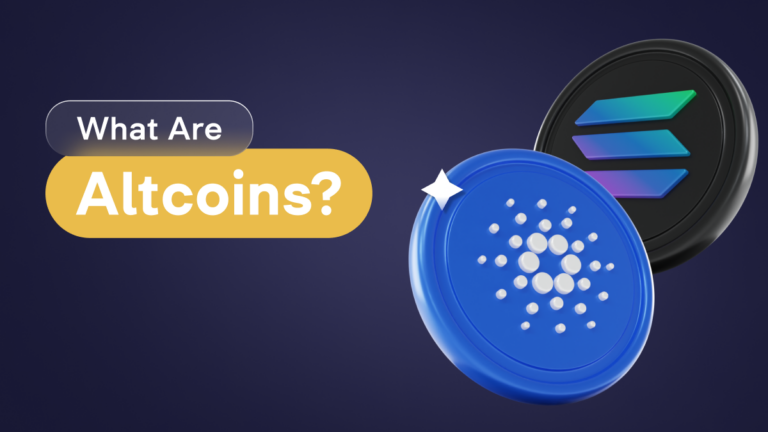What is Crypto Staking and How Does It Work?

Content
Cryptocurrency staking has become a popular way for investors to earn rewards while supporting the security and operations of blockchain networks. Many novice traders are increasingly becoming interested not only in how to trade crypto, but also in how crypto staking works in order to receive passive income. This article delves into the details of crypto staking, explaining what it is, how it works, its benefits and risks, and how it compares to crypto mining. So, how does crypto staking work? Let’s find out!
What is Staking in Crypto?
Staking in the context of cryptocurrency and DeFi refers to the process of actively participating in transaction validation (similar to mining) on a Proof of Stake (PoS) blockchain. Instead of mining for rewards through computational work, staking involves holding funds in a cryptocurrency wallet to support the network’s security and operations.
Crypto Staking Explained
The staking process is a fundamental part of PoS and related consensus mechanisms. By staking coins, individuals become validators, helping to secure the network and process transactions. This method allows for more scalable and energy-efficient blockchain networks compared to Proof of Work (PoW) systems like Bitcoin.
Importance and Relevance in the Current Crypto
Ecosystem staking has gained prominence due to its efficiency and reduced environmental impact. It provides an opportunity for crypto holders to earn passive income and contributes to the overall health and security of blockchain networks. As more blockchains adopt PoS and its variants, staking is becoming an integral part of the cryptocurrency ecosystem.
What is Proof of Stake?
Proof of Stake (PoS) is a type of consensus mechanism utilized by certain blockchain networks to maintain security and achieve distributed consensus. Unlike traditional Proof of Work (PoW) systems, which rely on computational power to validate transactions and create new blocks, PoS systems use an entirely different approach that is based on economic incentives.
In a PoS system, validators are selected to create new blocks and confirm transactions based on the number of coins they possess and are willing to “stake” as collateral. This staked amount acts as a security deposit that can be forfeited if the validator acts dishonestly or fails to perform their duties properly. The more coins a validator stakes, the higher their chances of being chosen to validate transactions and add new blocks to the blockchain. This method leverages the economic stake of validators to secure the network, ensuring that those with a significant interest in the network’s success have a vested interest in maintaining its integrity and security.
The Mechanics of PoS
Validators in a PoS system are analogous to miners in a PoW system, but their role and the way they are selected differ significantly. When a new block is to be added to the blockchain, the network protocol randomly selects a validator from a pool of validators. The probability of being chosen is proportional to the amount of cryptocurrency staked. For example, if a validator has staked 5% of the total staked crypto in the network, they have a 5% chance of being selected to validate the next block.
Crypto Staking Rewards
Once chosen, the validator checks the legitimacy of transactions within the block, signs off on the block, and adds it to the blockchain. In return for their services, validators earn rewards, often in the form of transaction fees and newly minted coin or stablecoin. These rewards provide a continuous incentive for validators to participate honestly in the network.
How Do PoS Differ from Proof of Work (PoW)?
Proof of Work (PoW) and Proof of Stake (PoS) are two fundamentally different consensus mechanisms, each with its own strengths and weaknesses.
– Energy Efficiency: PoW systems, like those used by Bitcoin, require significant computational power and energy consumption. Miners in a PoW network compete to solve complex mathematical puzzles, which involves extensive use of processing power and electricity. This competition ensures security but comes at a high environmental cost.
PoS, by contrast, is far more energy-efficient. Validators in a PoS system do not compete to solve puzzles; instead, they are chosen based on the amount of cryptocurrency they hold in a crypto portfolio and are willing to stake. This approach eliminates the need for vast amounts of energy, making PoS a more sustainable solution for blockchain networks.
– Economic Incentives: In PoW, miners invest in expensive hardware and electricity to secure the network. Their financial incentive is to earn block rewards and transaction fees, which can offset the costs of mining. However, the upfront and ongoing costs can be prohibitive for many.
PoS lowers the barrier to entry by removing the need for specialized hardware. Instead, participants need only to hold and stake the network’s native cryptocurrency. This not only democratizes participation but also ties the validators’ incentives directly to the value of the network. Validators are motivated to act honestly because malicious behavior could result in the loss of their staked coins.
How Does Staking Crypto Work?
Validators are responsible for proposing and validating new blocks in a PoS network. They ensure that transactions are legitimate and that the blockchain remains secure and decentralized. Validators are incentivized with staking rewards for their efforts.
How Do Nodes Contribute to Network Security?
Nodes are individual computers that maintain a copy of the blockchain and participate in the consensus process. In PoS networks, nodes can be validators or simply participants that relay transactions and blocks. The more nodes and validators involved, the more secure and decentralized the network becomes.
Benefits of Staking Crypto
There are both pros and cons of staking crypto, so let’s examine them one by one:
- Financial Incentives
Stakers earn rewards in the form of additional cryptocurrency, similar to earning interest on a savings account. These rewards provide a passive income stream for participants, making staking an attractive option for crypto investors.
- Environmental Impact
Staking is significantly more energy-efficient than PoW mining. By reducing the need for high-powered mining equipment and electricity consumption, staking contributes to a smaller carbon footprint and a more sustainable blockchain ecosystem.
- Network Stability and Security
Staking helps secure the network by encouraging participants to lock up their coins, reducing the likelihood of attacks. A well-staked network is more resilient to malicious actors and provides greater stability and security for users.
What are the Risks of Staking Crypto?
Here are the crypto staking risks you can face:
- Economic Risks: The value of staked tokens can fluctuate, leading to potential losses. Additionally, some networks may impose lock-up periods during which staked tokens cannot be withdrawn, limiting liquidity;
- Technical Risks: Validators and stakers must maintain proper hardware and software configurations. Failures or downtime can result in penalties, including loss of staked tokens. There is also the risk of smart contract bugs or vulnerabilities within the staking platform or crypto exchange;
- Regulatory and Compliance: Risks regulations around staking and cryptocurrencies are still evolving. Participants must stay informed about legal requirements and potential changes in their jurisdiction to ensure compliance and avoid legal issues.
Cryptocurrency Staking vs. Mining
Staking and mining serve similar purposes in securing and validating blockchain networks but differ fundamentally in their mechanisms. Mining relies on solving complex puzzles through computational power (PoW), while staking depends on holding and locking up coins (PoS). Staking is generally more energy-efficient and accessible to a broader range of participants, whereas mining requires significant hardware investments and ongoing operational costs.
Steps on How to Stake Cryptocurrency
Here are some instructions on how to stake crypto you can utilize:
- Selecting Cryptocurrency Types: Research and choose a cryptocurrency that supports staking. Popular options include Ethereum (ETH), Cardano (ADA), Polkadot (DOT), Solana (SOL), and Tezos (XTZ);
- Choosing a Staking Platform: Select a reputable staking platform or crypto wallet that supports your chosen cryptocurrency. Consider factors such as fees, ease of use, and security features;
- Setting Up: Create an account on the chosen platform, deposit your cryptocurrency, and follow the platform’s instructions to start staking. Ensure you meet any minimum staking requirements and understand the platform’s rules and rewards structure.
Crypto Staking Strategies
Let’s look at some of the most popular staking strategies among traders:
Solo Staking vs. Staking Pools
Solo staking involves staking your crypto independently, retaining full control over your funds and rewards. Staking pools allow multiple participants to combine their resources, increasing their chances of being selected as validators and earning rewards. Pools are ideal for those with smaller holdings or less technical expertise.
Delegated Staking
Some PoS networks allow participants to delegate their staking power to a trusted validator. This enables users to earn rewards without managing the technical aspects of staking themselves. Delegated staking can be a convenient option for beginners.
Diversification
Diversify your staking investments across multiple cryptocurrencies and platforms to spread risk and maximize potential rewards. Diversification can help mitigate the impact of price volatility and network-specific risks.
Popular Staking Cryptocurrencies
Several cryptocurrencies have gained popularity for staking due to their robust ecosystems and attractive rewards. These include:
- Ethereum 2.0 (ETH): Transitioning from PoW to PoS with the launch of Ethereum 2.0, offering staking rewards for securing the network;
- Cardano (ADA): Known for its research-driven approach and strong community support, offering competitive staking rewards;
- Polkadot (DOT): A multi-chain network that allows for cross-chain transfers, with attractive staking opportunities;
- Tezos (XTZ): A self-amending blockchain with a strong focus on governance and staking rewards.
Conclusion
Crypto staking offers an innovative way to earn rewards while contributing to the security and efficiency of blockchain networks. By understanding the benefits, risks, and various strategies, participants can make informed decisions and take advantage of this growing trend in the cryptocurrency space. Whether you’re new to crypto or an experienced investor, staking provides an accessible and potentially lucrative opportunity to engage with the evolving digital economy.
FAQ
Staking can be a profitable venture if done correctly. It provides an opportunity to earn passive income while supporting blockchain networks. However, it is essential to understand the risks involved and conduct thorough research before staking your assets.
Staking is generally safe, but it carries inherent risks like any investment. Economic volatility, technical failures, and regulatory changes can impact the safety of your staked assets. Choosing reputable platforms and diversifying your investments can help mitigate these risks.
A staking pool is a group of cryptocurrency holders who combine their resources to increase their chances of being selected as validators and earning rewards. Pools are managed by operators who distribute rewards among participants based on their contributions.
Yes, it is possible to earn money through staking by receiving rewards in the form of additional cryptocurrency. The amount earned depends on factors such as the staking platform, the cryptocurrency staked, and the duration of staking.
While staking can be profitable, there are risks involved, including the potential loss of staked tokens due to price volatility, technical issues, or penalties for failing to maintain validator responsibilities. It is crucial to understand these risks and make informed decisions when staking.











